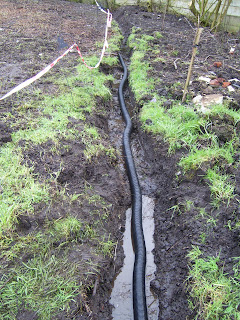 |
| The start of the pipe |
A couple of weeks back we had managed to get a mini digger to the plot which had deepened and lengthened the drainage channel which I had already dug. The new channel went down about 10 inches from the surface which was great, but I discovered that the centre of my plot was about 8 inches lower then the edge, which meant that I still had a load of water trapped in the middle as the channel sloped upwards towards the path.
Yesterday afternoon I decided that I would have to manually dig this channel out to make sure that it sloped away from the centre, and after about an hour of hard work I managed to release all of the trapped water.
We already had several lengths of drainage pipe on site that had been donated last year, so I wrestled one of those into place. During this wrestling I discovered that the pipe didn't like being stretched into place, it had to be unrolled along the trench instead. Unfortunately I only discovered this when the end of the pipe had flicked loads of very muddy water all over me as it was being laid.
I now need to cover the pipe on my plot with lots of 3/4" stone and hardcore rubble to allow any water to easily filter down to the pipe, and then I can lay flagstones over the whole thing, both to protect it and also prevent me from inadvertently trying to plant anything over it in the future.
I may also need to dig side channels to encourage any excess water away from where I am planing to have my shed, polytunnel and a sitting area, but for now I think I will wait until we have had some more rain and see how well it drains by itself before digging any more.
After all the digging I didn't really have much time for anything else, but I did manage to get Bed 3 weeded.
This is the bed where I planted out all the brassicas that had been eaten by almost every pest you can get on a plot, so they had a very poor start and are still only about 3-4" tall.
Despite this most have survived the worst the winter has had to throw at them so far, but quite a few weeds had also take the opportunity to invade the bed and needed to be controlled before they became a problem.
This was the first time I had touched the soil here since planting the seedlings out back in October, so I was very pleasantly surprised to discover that the soil structure was really fine, very few lumps and so the larger weeds pulled out easily with very little effort, and the smaller ones were dug in with a dutch hoe.
This bed was one that had been double dug and had originally been all huge blocks of soil on the surface - I guess that I can thank the freezing weather we have had recently for breaking it all down into a lovely tillth.
I had read in all my books that this would happen, but never realised just how much of a dramatic change there could actually be until I saw it for myself.
I also started to weed the Rhubarb bed, which was full of what looked to be very well established grass, but when I got going I realised that the top six inches of the bed was pure manure and therefore very loose.
This made it easy to chop up the grass with a hoe and push it under the surface, not something I would normally do but this grass didn't appear to be couch grass, and I am going to put another layer of soil and then a final layer of manure over it before transplanting the rhubarb crowns so I am hoping that it will simply rot down and not come bursting out again later.
If it does, I will deal with it then.


No comments:
Post a Comment